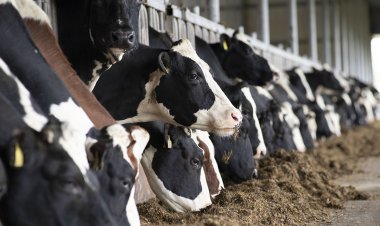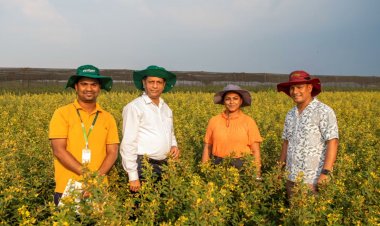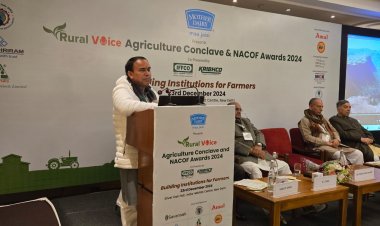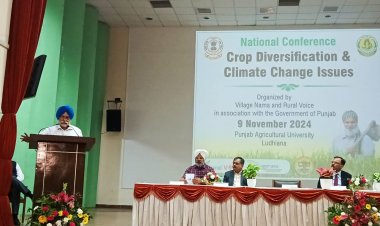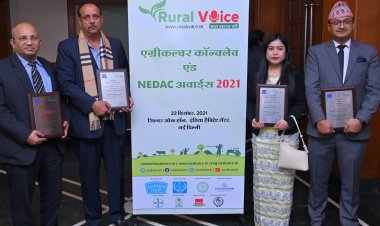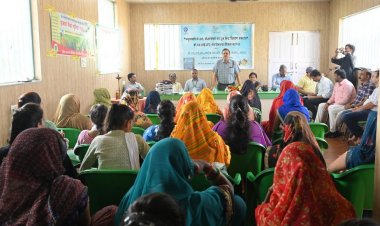Semi dwarf variety of corn to begin a new era of crops, resilient to climate change
Developed by Bayer Crop Science, the short corn contains a novel biotech trait of “altered plant architecture” for reduced plant height to less than 7 feet from 9 to 12 feet for a traditional corn hybrid, almost 33% reduction in plant height without compromising plant biomass.
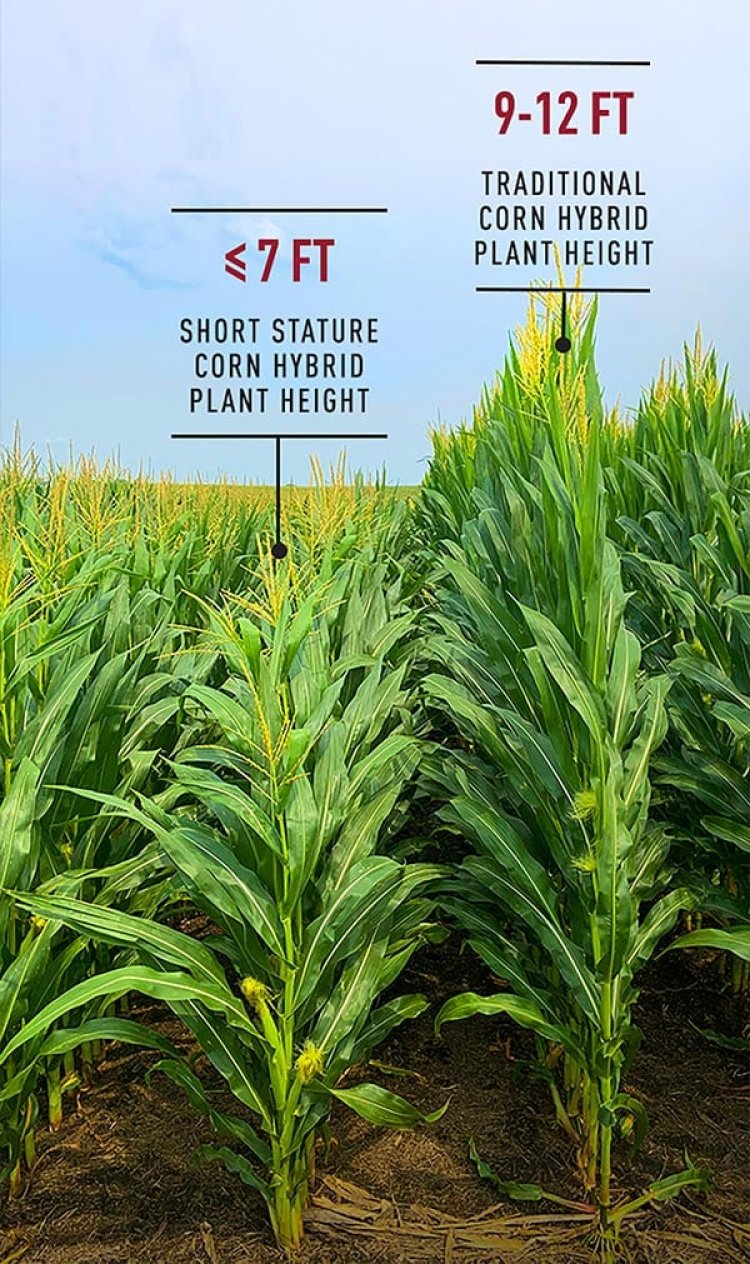
In a major regulatory breakthrough on 6th June 2023, the United State Department of Agriculture (USDA), a key US biotech regulator approved for commercial cultivation of a new type of corn (maize), developed using transgene to shorten internodes length and therefore to be shorter than conventional corn to withstand increasingly volatile weather associated with climate change. Developed by Bayer CropScience, the short corn contains a novel biotech trait of “altered plant architecture” for reduced plant height to less than 7 feet from 9 to 12 feet for a traditional corn hybrid, almost 33% reduction in plant height without compromising plant biomass.
The short or semi-dwarf corn has resulted from the successful deployment of genetic modification technology that alters plant architecture either by partial or complete loss of expression of the GA20ox3 and GA20ox5 genes, which encode GA20-oxidase, an enzyme involved in the biosynthetic pathway of the plant hormone gibberellin, primarily responsible for plant height.
The novel biotech trait approach powered by gene transfer and genome edited technology is distinct from the conventional breeding techniques, which introgress naturally occurring dwarf, semi-dwarf or short stature characteristic into elite germplasm. The introduction of the Green Revolution in the mid-1960s was based on GA-responsive naturally occurring dwarf mutants that saved the world, particularly India from a devastating famine and ensured food security. Rht gene of “Norin-10” variety of wheat and SD-1 gene of “Dee-geo-woo-gen” rice variety from Taiwan were used as the dwarf source for developing semi-dwarf and high-yielding wheat and rice varieties. Subsequently, agricultural science and research gained momentum and for the next five decades the semi-dwarf genes Rht and SD-1 were extensively used in developing countries to develop modern wheat and rice varieties for different agro-climatic zones.
Farmers quickly adopted semi-dwarf and high-yielding varieties of wheat and rice, and with this a new wave of development of agricultural industries such as irrigation, fertilizers and mechanization hit the fields and farms. The results of the production of semi-dwarf and high-yielding varieties of wheat and rice were phenomenal in last 4-5 decades. In continuation, the short or semi-dwarf trait is the next wave of technological advancement which would unleash the potential of gene transfer and genome editing in corn and other crops that bypassed the green revolution era as shown in Table 1.
Table 1. Developmental approaches to short, semi-dwarf and high yielding crops
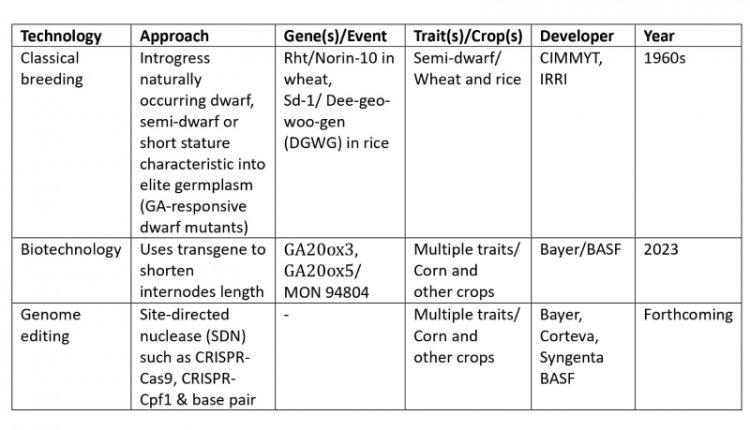
(Source: Analyzed by South Asia Biotechnology Centre, 2023)
The short or semi-dwarf corn has been developed primarily to address the major challenges faced by US corn farmers from climate change induced weather aberrations resulting in frequent occurrence of “derecho”, a severe windstorm and thunderstorm downbursts system increasingly becoming common throughout major corn production areas in the United States and other parts of the World. In US, derecho is the major cause of corn lodging and green snap, which is the condition where rapidly growing stalks are broken by strong, sudden winds associated with thunderstorm downbursts causing significant yield losses in corn.
It is estimated that the US corn farmers incur annual yield losses range from 2 to 75% due to lodging and green snap in corn production. The short or semi-dwarf corn can provide the US farmers with agronomic and environmental benefits, including reduced lodging and green snap, ensuring higher density, extended in-season crop operation, increased farm mechanisation and precision farming application and potential for improved environmental sustainability.
Historically, the US has been at the forefront the introduction of breakthrough technological advances such as hybridization (1930s), adoption of single cross hybrid (1970s) and biotech traits (1996) way ahead than any other corn producing country (Figure 2). As a result, US corn yield peaked at 176.7 bushels per acre (11.0 tons per hectare) in 2022 from 100.7 bushels per acre (6.3 tons per hectare) in 1993 and 60 bushels per acre (3.7 tons per hectare) in the early seventies.
Notably, the average annual yield increase between 2002 and 2021 is 1.9 bushels per acre (almost 50 kg per acre), which peaked at 2.8 bushels per acre (71 kg per acre) in 1975 and reaching a high of 2.6 bushels per acre (66 kg per acre) in 2008 coinciding with the large-scale adoption of the single cross hybrid technology in mid-seventies and biotech traits in early 2000 respectively. It was reported by the University of Illinois that yield gains in corn in the US are the result of continuous breeding efforts over a long period of time, a process accelerated by the advent of biotechnology, leading to the introduction and widespread adoption of biotech traits.
Technology adoption and yield trend of corn in the US, 1886 to 2022
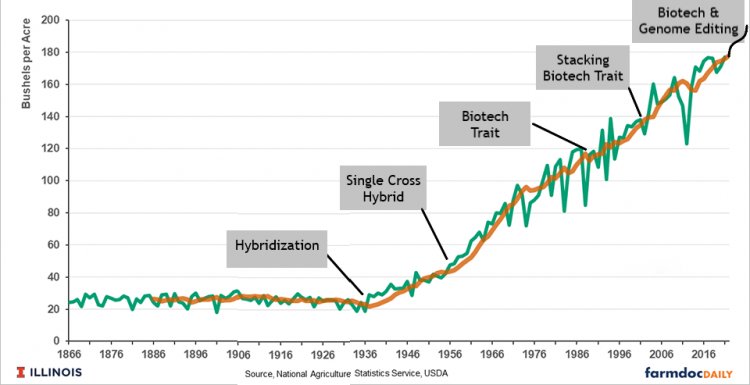
(Source: Adapted from Perspectives on National U.S. Corn Yields for Productivity and Down-Side Yield Risk, University of Illinois at Urbana-Champaign, July 12, 2022)
The area-wide technological adoption has enabled the US farmers to produce record corn of 387.7 million tons, almost one third of the global corn production estimated at 1,222 million tons followed by China (23%), Brazil (11%), European Union (5%), Argentina (4%) and India barely contributes 3% at 34.3 million tons in 2023. The US, Brazil and Argentina dominate the global trade around 197 million tons of corn exported primarily to China, European Union, Mexico, Japan, South Korea Vietnam, Iran and Egypt. Moreover, about 30% of the US corn is processed annually to produce 56.85 billion litres of fuel ethanol, one of the largest markets for corn-based-ethanol, to meet almost 72% of national biofuel blending requirement of 79.3 billion litres by volume in 2023. Most gasoline sold in the US has 10% ethanol and is processed in the Midwest, the corn bowl of US.
Going ahead, the short or semi dwarf corn would be combined through traditional breeding with other deregulated biotech traits to provide protection against above and below ground pests such as European corn borer, southwestern corn borer, fall armyworm, black cutworm, western bean cutworm, corn earworm, and corn rootworm; multiple herbicide tolerance to glyphosate and glufosinate as well as drought tolerance. As of 2020, biotech corn with multiple stacked traits of insect resistance and herbicide tolerance was planted over 60.9 million hectares globally, which was 31% of the global maize production in 2020.
In fact, the single and stacked traits approved for cultivation included insect resistance, herbicide tolerance, drought tolerance, modified product quality and pollination control system to produce male sterile female inbred plants for the generation of hybrid corn seed, however stacked trait multiple mode of action IR/HT popularly grown in 14 countries including USA, Brazil, Argentina, Canada, Paraguay, South Africa, Uruguay, the Philippines, Spain, Colombia, Vietnam, Honduras, Chilli and Portugal. Moreover, biotech corn has received maximum number of approvals with 152 approved events for food, feed and processing (FFP) in 35 countries as of 2022.
In essence, the short or semi-dwarf corn would be an important trait to be deployed in the large areas by stacking with other biotech traits such as stacked traits multiple mode of action insect and herbicide tolerance to transform corn production, helping smallholder to increase plant population & increase yield per unit area, reduce the likelihood of lodging & stem buckling due to frequent occurrence of high wind and storm induced by climate change. Alike the single cross hybrid and biotech traits, it is expected that the short or semi-dwarf corn trait would spur the next corn revolution in the US and other corn growing countries vulnerable to food, feed, fuel and fibre insecurity challenged by the climate change phenomena globally.
The big question is for the government of developing countries to embrace such novel technologies and for the developer to demonstrate and navigate the regulatory systems for the commercial approval of the short or semi-dwarf corn in key corn producing as well as consuming countries and allow access of the breakthrough technology to smallholder corn growers across the world.
(The writer is Founder & Director of South Asia Biotechnology Centre, Jodhpur)



 Join the RuralVoice whatsapp group
Join the RuralVoice whatsapp group

















